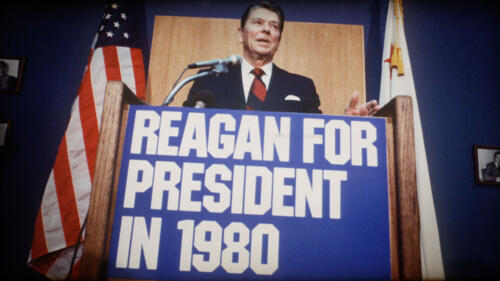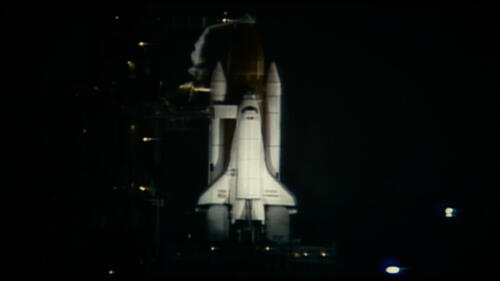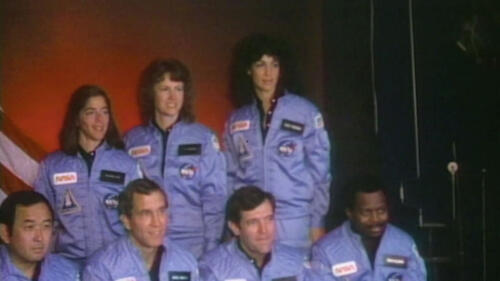1980s
During the 1980s, conservative politics and Reaganomics held sway as the Berlin Wall crumbled, new computer technologies emerged, AIDS ravaged the United States, especially the gay male community, and blockbuster movies and MTV reshaped pop culture.
Featured Overview
Learn about the Iran-Contra Affair under President Reagan who secretly supported an anti-Communist group in Nicaragua and funneled weapons to Iranian terrorists in exchange for American hostages. Discover how Lt. Col. Oliver North was found guilty.
4:45m watch

Dirck Halstead/Getty Images
Featured Overview
Learn about the Iran-Contra Affair under President Reagan who secretly supported an anti-Communist group in Nicaragua and funneled weapons to Iranian terrorists in exchange for American hostages. Discover how Lt. Col. Oliver North was found guilty.
4:45m watch
Start Here

Power dressing. ’Eatertainment.’ Fad toys that sparked near-riots. Which trends did you participate in?

Health officials first became aware of AIDS in the summer of 1981, but U.S. leaders remained largely silent for four years.

The Chernobyl nuclear disaster was made worse when Soviet authorities initially denied the event and then acted slowly to contain it.

The president and Congress clashed over welfare, crime, defense spending and whether to fund Contras in Nicaragua.
Challenger Disaster
How the Space Shuttle Challenger Disaster Unfolded
Seventy three seconds after take off the Space Shuttle Challenger encounters unexpected disaster. Find out more in this clip from Season 1, "Challenger Disaster."
6:57 watch

3 Major Events of the 1980s
Explore All Related Topics

When a variant of Mad Cow Disease moved from cattle to humans in the mid-1990s, panic ensued and the British economy lost billions.

Christa McAuliffe embraced the chance to be part of a space shuttle mission and, despite the Challenger disaster, left an inspiring legacy.
Seventy three seconds after take off the Space Shuttle Challenger encounters unexpected disaster. Find out more in this clip from Season 1, "Challenger Disaster."
6:57m watch

The young New York graffiti artist and Pop Art icon produced more than 150 works together. Critics in the '80s panned them. Now, some sell for millions.

ACT UP pressured the government, insurance companies and pharmaceutical companies for more patient-centered care during the worst years of the AIDS epidemic.

Once cutting-edge, these gadgets have since been overshadowed.

The 20-foot piece of the NASA space shuttle was found off the coast of Florida during the filming of the new HISTORY Channel series, 'The Bermuda Triangle: Into Cursed Waters.'

The shocking deaths of seven people in the Chicago area from tampered bottles led to a massive recall—and generated fears around candy poisonings.

At its height, the USSR comprised of more than a dozen republics stretching across Europe and Asia. After the collapse, each forged a different path.

Power dressing. ’Eatertainment.’ Fad toys that sparked near-riots. Which trends did you participate in?

With a dazzling performance in Los Angeles, the West Virginia native helped lay the foundation for future U.S. stars.

HIV and the syndrome it causes, AIDS, began spreading in the United States in the early 1980s. By the late 1980s it had become a public health crisis. Initially the U.S. government did little to address the epidemic, due in part to misconceptions that the disease only affected gay men. Activists came together to demand a response from the government and the international community. By the mid-1990s, HIV/AIDS numbers were on the decline in America. Today, millions of people around the world are living with HIV and tens of thousands of people die of AIDS-related illnesses every year.

During a time when fear and stigma around AIDS and LGBTQ identity were pervasive, Louganis kept his diagnosis secret until years later.

Protesters feigned mass death to shock and shame government, industry and the media into finally addressing the lethal disease.

The AIDS Memorial Quilt—with 1,920 individual panels, each inscribed with the names of people lost to AIDS—was displayed for the first time on October 11, 1987. It has grown ever since.

The 1982 strike led by immigrant women earned better workplace conditions and benefits for New York City’s garment workers.

After Fidel Castro loosened emigration policies, some 125,000 Cubans landed on U.S. shores over a span of five months.

The 1980s battle over safety belt laws reflected widespread ambivalence over the role and value of government regulation.

With their presidential ticket, Walter Mondale and Geraldine Ferraro made history in 1984. But that didn't help them win.

Health officials first became aware of AIDS in the summer of 1981, but U.S. leaders remained largely silent for four years.

In the mid-1980s American farmers faced a dire future. Willie Nelson and other artists decided to help using what they knew best—music.

Was the unpopularity of New Coke actually a blessing in disguise for Coca-Cola?

In 1989, five New York teenagers were falsely accused of rape.

The 74-day Falklands War became Prime Minister Thatcher's "moment" that led to swift British victory—and also helped save her political skin.

From a 25-year-old with his finger on the wrong button to a grizzled Communist Party apparatchik who thought evacuation was for sissies, here are the protagonists at the center of the tragedy.

The Chernobyl nuclear disaster was made worse when Soviet authorities initially denied the event and then acted slowly to contain it.

The chief architect of McCarthyism prosecuted the Rosenbergs, purged suspected communists and LGBT government workers and was portrayed in 'Angels in America.'

The shocking disaster delayed the speech for one week.

Hart dropped out of the 1988 presidential race after journalists reported on one of his many affairs.

The syndrome that inspired Freddie Krueger afflicted a very specific group of people.

President Reagan took three tries to get a Supreme Court nomination approved—and the outcome would have far-reaching consequences for the Court and the country.

The 1980s were a decade of political conservatism, such as President Ronald Reagan’s Reaganomics, and of blockbuster movies, pop culture and fashion on MTV.

In the early 1980s, the U.S. government distributed some 300 million pounds of pungent-smelling processed cheese that had been produced with federal funds.

With Chernobyl's nuclear radiation raining down, Communist party officials dithered, delayed and hid the truth. Then they gave residents of nearby Prypiat 50 minutes to evacuate.

Chernobyl is a nuclear power plant in Ukraine that was the site of the worst nuclear accident in history when a routine test went horribly wrong on April 26, 1986.
Learn about the Iran-Contra Affair under President Reagan who secretly supported an anti-Communist group in Nicaragua and funneled weapons to Iranian terrorists in exchange for American hostages. Discover how Lt. Col. Oliver North was found guilty.
4:45m watch

The Exxon Valdez oil spill dumped 11 million gallons of crude oil into Alaska's Prince William Sound in 1989, damaging the environment and killing wildlife.

Caroll Spinney—the puppeteer in the yellow suit—was in talks to go to space.

The Iran-Contra Affair was a deal made by the Ronald Reagan administration which sent arms to Iran to secure the release of hostages and fund Nicaraguan rebels.

HIV and AIDS began spreading among humans in the 1920s and became a public health crisis by the 1980s, before the first effective treatments emerged.

June of 2017 marked the 10-year anniversary of the release of Apple’s iPhone, a device that not only revolutionized the way the world communicates, but also helped catapult Apple into a global economic and technological powerhouse. At a time when an estimated 700 million users around the world currently enjoy the fruits of Steve Jobs’ […]

Just Say No was the name and catchphrase of a youth antidrug campaign led by first lady Nancy Reagan as part of the U.S. government's war on drugs in the 1980s.

Take a look back at Hands Across America, the charity event in which 5 million people formed a human chain across the United States.

The space shuttle Challenger blew apart some 73 seconds after liftoff from Cape Canaveral, Florida, on January 28, 1986, killing all seven astronauts on board.
On January 28, 1986, the tenth mission of the space shuttle Challenger ended in tragic disaster. We remember the seven astronauts who lost their lives that day, including Christa McAuliffe, who was chosen by NASA to pioneer its Teacher in Space program.
2:00m watch

More U.S. civilians died in the bombing of Pan Am Flight 103 over Lockerbie, Scotland than in any other terrorist attack except 9/11.

Find out about Freddie Mercury, the inspiration for today's Google Doodle, and other famous people who helped put a face on the HIV and AIDS crisis.

The NASA space shuttle Challenger exploded just 73 seconds after liftoff on January 28, 1986, a disaster that claimed the lives of all seven astronauts aboard.





